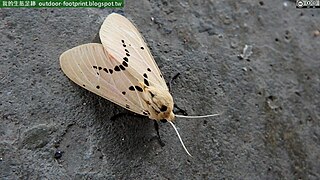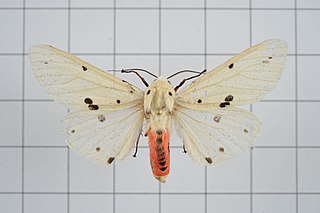
The buff ermine is a moth of the family Erebidae. It is sometimes placed in the genus Spilosoma. The species was first described by Johann Siegfried Hufnagel in 1766. It is found throughout the temperate belt of the Palearctic region south to northern Turkey, Georgia, Kazakhstan, southern Siberia, eastern Mongolia, Amur Region, China, Korea and Japan.

The Spilosomina are a subtribe of tiger moths in the tribe Arctiini, which is part of the family Erebidae.

Spilarctia is a genus of moths in the family Erebidae. The genus was erected by Arthur Gardiner Butler in 1875.

Spilosoma sagittifera is a species of moth of the family Erebidae. It was described by Frederic Moore in 1888. It is found in India, Nepal, China and Taiwan.
Spilarctia rubriventris is a moth in the family Erebidae. It was described by George Talbot in 1926. It is found on Borneo.
Spilarctia groganae is a moth in the family Erebidae. It was described by Jeremy Daniel Holloway in 1976. It is found on Borneo. The habitat consists of lower and upper montane forests.
Spilarctia lungtani is a moth in the family Erebidae. It was described by Franz Daniel in 1943. It is found in China.
Spilarctia borneensis is a moth in the family Erebidae. It was described by Walter Rothschild in 1910. It is found on Borneo.
Spilarctia sinica is a moth in the family Erebidae. It was described by Franz Daniel in 1943. It is found in China.
Spilarctia leopardina is a moth in the family Erebidae. It was described by Vincenz Kollar in 1844. It is found in Tibet, Nepal, the north-western Himalayas and Kashmir.
Spilarctia seriatopunctata is a moth in the family Erebidae. It was described by Motschulsky in 1861. It is found in Russia, China, Korea and Japan.
Spilarctia nydia is a moth in the family Erebidae. It was described by Arthur Gardiner Butler in 1875. It is found in Nepal, China, Taiwan and northern Vietnam.
Spilarctia hosei is a moth in the family Erebidae. It was described by Walter Rothschild in 1910. It is found on Borneo. The habitat consists of lowland forests.
Spilarctia thomasi is a moth in the family Erebidae. It was described by Jeremy Daniel Holloway in 1988. It is found on Borneo. The habitat consists of montane areas.

Spilarctia alba is a moth in the family Erebidae. It was described by Otto Vasilievich Bremer and William Grey in 1853. It is found in China, Taiwan and Korea.
Spilarctia bipunctata is a moth in the family Erebidae. It was described by Franz Daniel in 1943. It is found in Yunnan and Sichuan in China.
Spilarctia sparsalis is a moth in the family Erebidae. It was described by Francis Walker in 1865. It is found on Sulawesi.
Spilarctia vandepolli is a moth in the family Erebidae. It was described by Walter Rothschild in 1910. It is found in Sundaland. The habitat consists of lowland rain forests.
Spilarctia cervina is a moth in the family Erebidae. It was described by Hans Daniel Johan Wallengren in 1860. It is found on Sumatra and the Mentawai Islands of Indonesia.
Spilarctia griseabrunnea is a moth in the family Erebidae. It was described by Jeremy Daniel Holloway in 1976. It is found on Borneo. The habitat consists of disturbed areas, agricultural areas and secondary vegetation ranging from the lowlands to altitudes of 1,200 meters.




